Bwave Technology W2R Tortuga User Manual
Shanghai Bwave Technology Co.,Ltd. Tortuga Users Manual
Contents
- 1. Users Manual
- 2. Users Manual revised
Users Manual
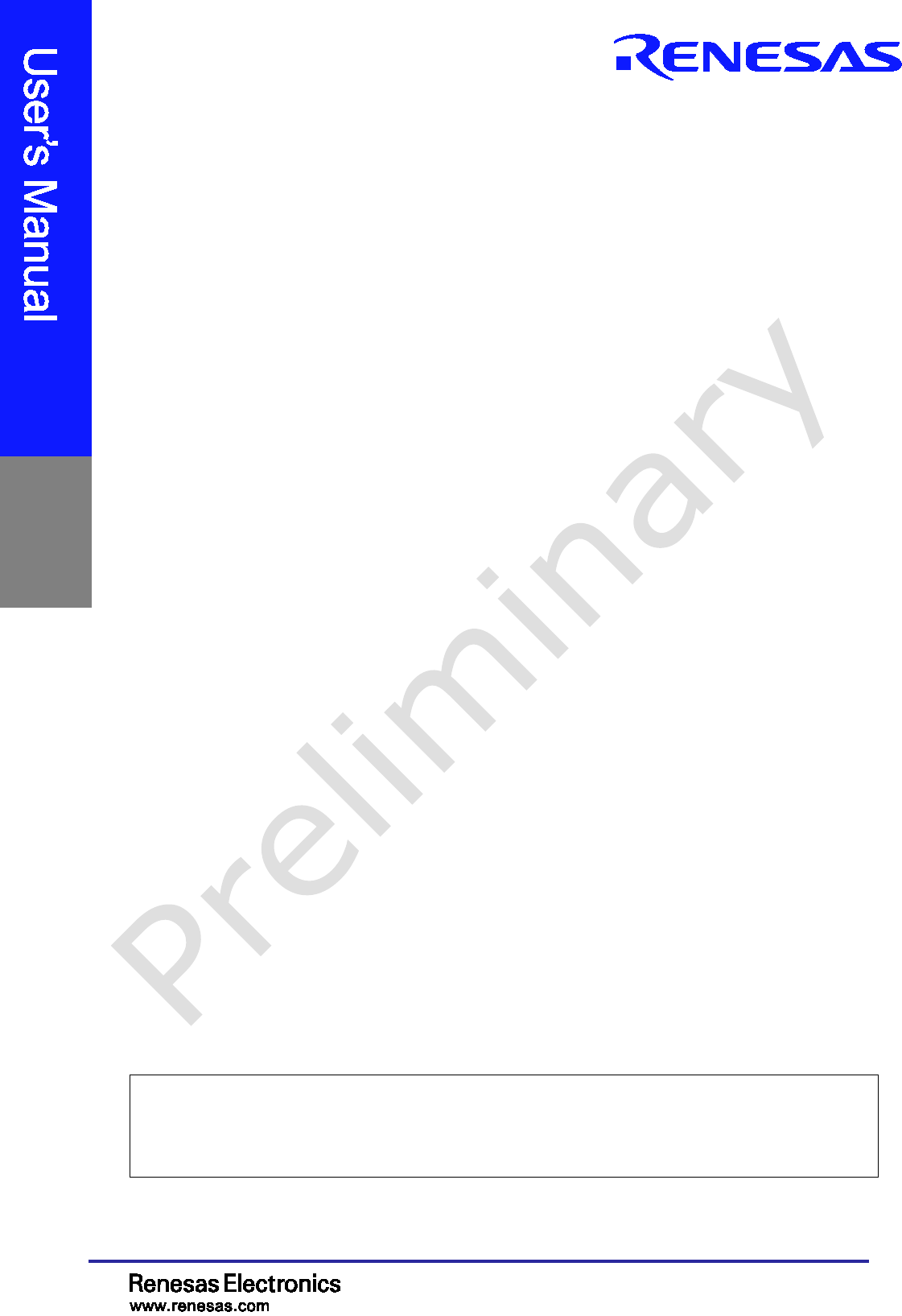
Renesas Electronics confidential
All information contained in these materials, including products and product specifications,
represents information on the product at the time of publication and is subject to change by
Renesas Electronics Corp. without notice. Please review the latest information published by
Renesas Electronics Corp.
RTK00V2X720MTORS7J
User’s Manual: Hardware
Rev.1.0 Jan. 2017
― Preliminary ―
Under Development Confidential
GAC-B-17-0004

Renesas Electronics confidential
GAC-B-17-0004 Page 2 of 25
17th Jan. 2017
Introduction
RTK00V2X720MTORS7J(Tortuga) is an evaluation board for RTK00V2X7200MPIN7J (V2X wireless module).
Tortuga can be used as standalone without the need of Host board, and be evaluated RF performance of V2X wireless
module. Tortuga also be used in conjunction with the Host board.
V2X wireless module has optimized function to realize IEEE802.11p PHY layer function. This product conforms not
only to 802.11p standard but 1609.4 and ETSI standard. This module provides cost effective, low power and small form
factor solution for communication unit manufacture.
Overview
Tortuga is an evaluation board for V2X wireless module(including Renesas’ ASSP and suitable component). V2X
wireless module has optimized function to realize ETSI EN 302 571/ ETSI EN 302 663 PHY/MAC layer function. This
product provides cost effective, low power and small form factor solution to communication unit manufacture.
V2X wireless module includes radio transceiver, PA, LNA , antenna switch, Filters and peripherals.
Feature
- Support Standard: ETSI EN 302 571/ ETSI EN 302 663 / IEEE802.11p™ -2010<15.July.2010> PHY/MAC protocol
with Firmware
- Operational Frequency band: 5.9GHz
- Using 32bit CPU core, Operating Frequency: up to 160MHz
- Internal memory: RAM/128kByte, ROM/32kByte, EEPROM/512Byte
- Mini PCIE Connector
- SDIO interface for host CPU
- UART interfaces
- USB interfaces
- Integrate Function for ETSI EN 302 571/ ETSI EN 302 663
OFDM Modulator/ Demodulator with Maximum Ratio Converting diversity
MAC hardware accelerator
- Power Supply: 12V from AC Adapter or 5.0V from Host board
- Peak Power Consumption (at 12 V)
TYP:
- Listen mode : TBD (diversity on)/TBD(diversity off)
- Rx mode : TBD (diversity on)/TBD(diversity off)
- Tx mode : TBD (@24dBm)
- Operating Temperature
Ta = -40 to +85 degree

Renesas Electronics confidential
GAC-B-17-0004 Page 3 of 25
17th Jan. 2017
Contents
1. DIMENSION AND LAYOUT ................................................................................................................... 4
1.1 BOARD LAYOUT INFORMATION 4
2. BOARD DESCRIPTION .......................................................................................................................... 6
2.1 BLOCK DIAGRAM 6
2.2 MINI PCIE PIN INFORMATION 7
2.3 POWER SUPPLY 8
2.4 USAGE FOR STANDALONE OPERATION 8
3. FUNCTION DETAILS ............................................................................................................................. 9
3.1 ABSOLUTE MAXIMUM RATING 9
3.2 ELECTRICAL CHARACTERISTICS 9
3.3 RF CHARACTERISTIC 10
3.3.1 Receive characteristic
10
3.3.2 Transmit characteristic
11
3.4 MODE TRANSFER DEFINITION AND SUB BOARD CONTROL 12
3.5 POWER UP/DOWN, RESET, WDT SEQUENCE 14
3.5.1 Power On / Off Sequence
14
3.5.2 Reset sequence
15
3.5.3 WDT Reset timing
15
3.6 LOGIC INTERFACE AC CHARACTERISTICS 16
3.6.1 UART sequence
16
3.6.2 SDIO sequence
16
3.6.3 1PPS sequence
18
4. APPENDIX – VALIDATION CONFIGURATION INFORMATION ........................................................ 18
5. REGULATORY WARNING STATEMENTS .......................................................................................... 18
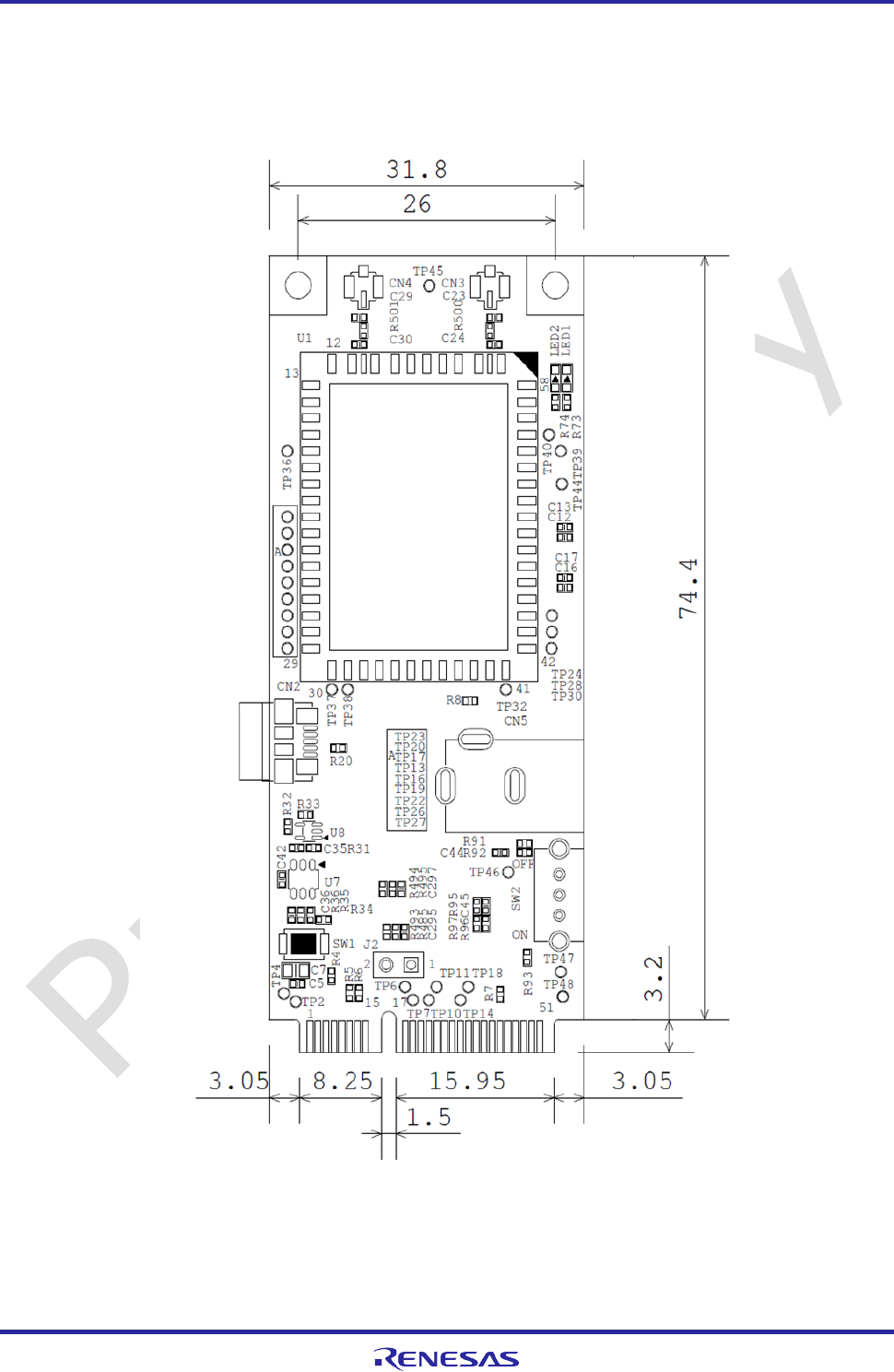
Renesas Electronics confidential
GAC-B-17-0004 Page 4 of 25
17th Jan. 2017
1. Dimension and Layout
1.1 Board layout information
Figure1. Board top view information
Unit: mm
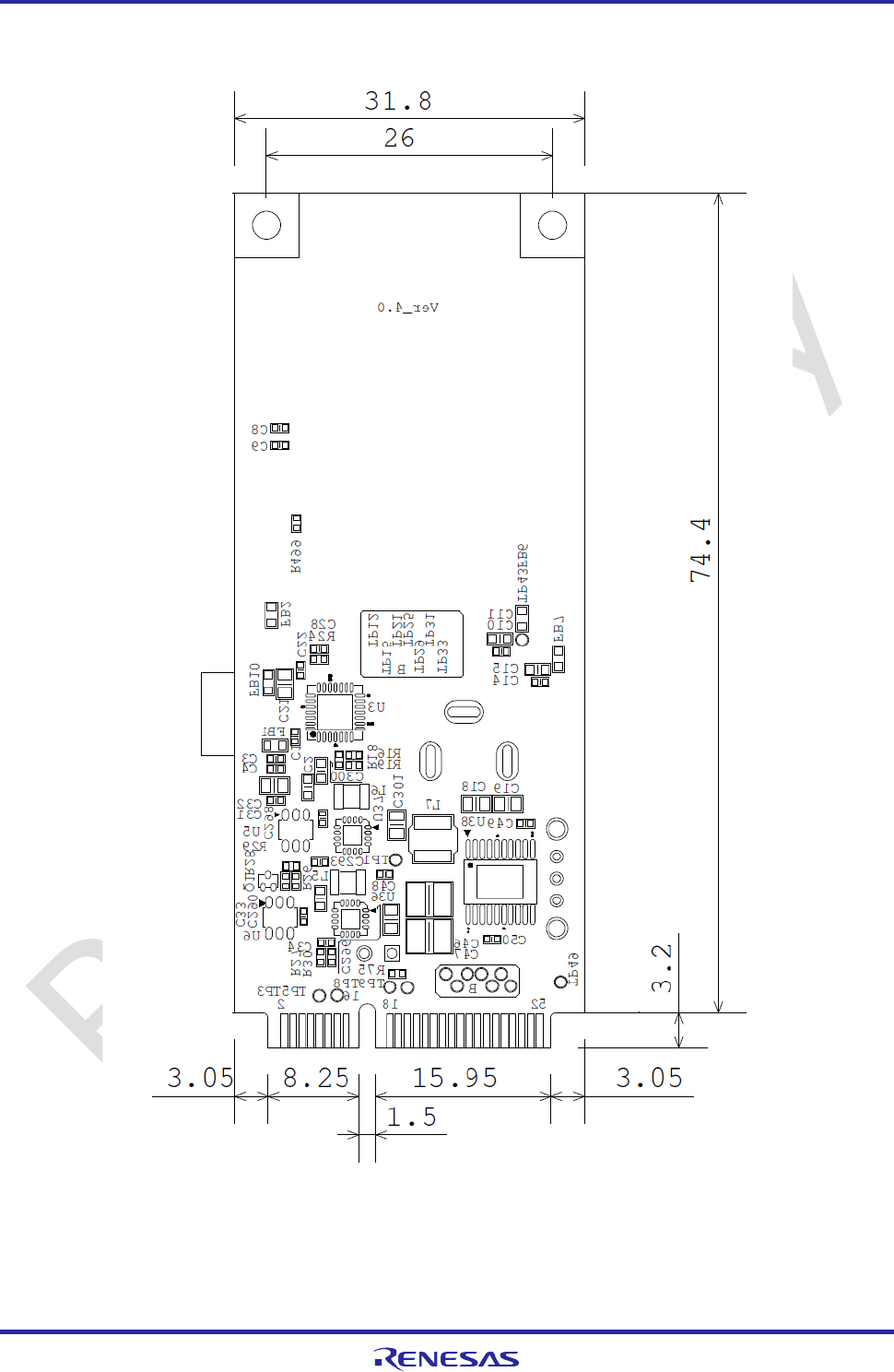
Renesas Electronics confidential
GAC-B-17-0004 Page 5 of 25
17th Jan. 2017
Figure2. Board bottom view information
Unit: mm
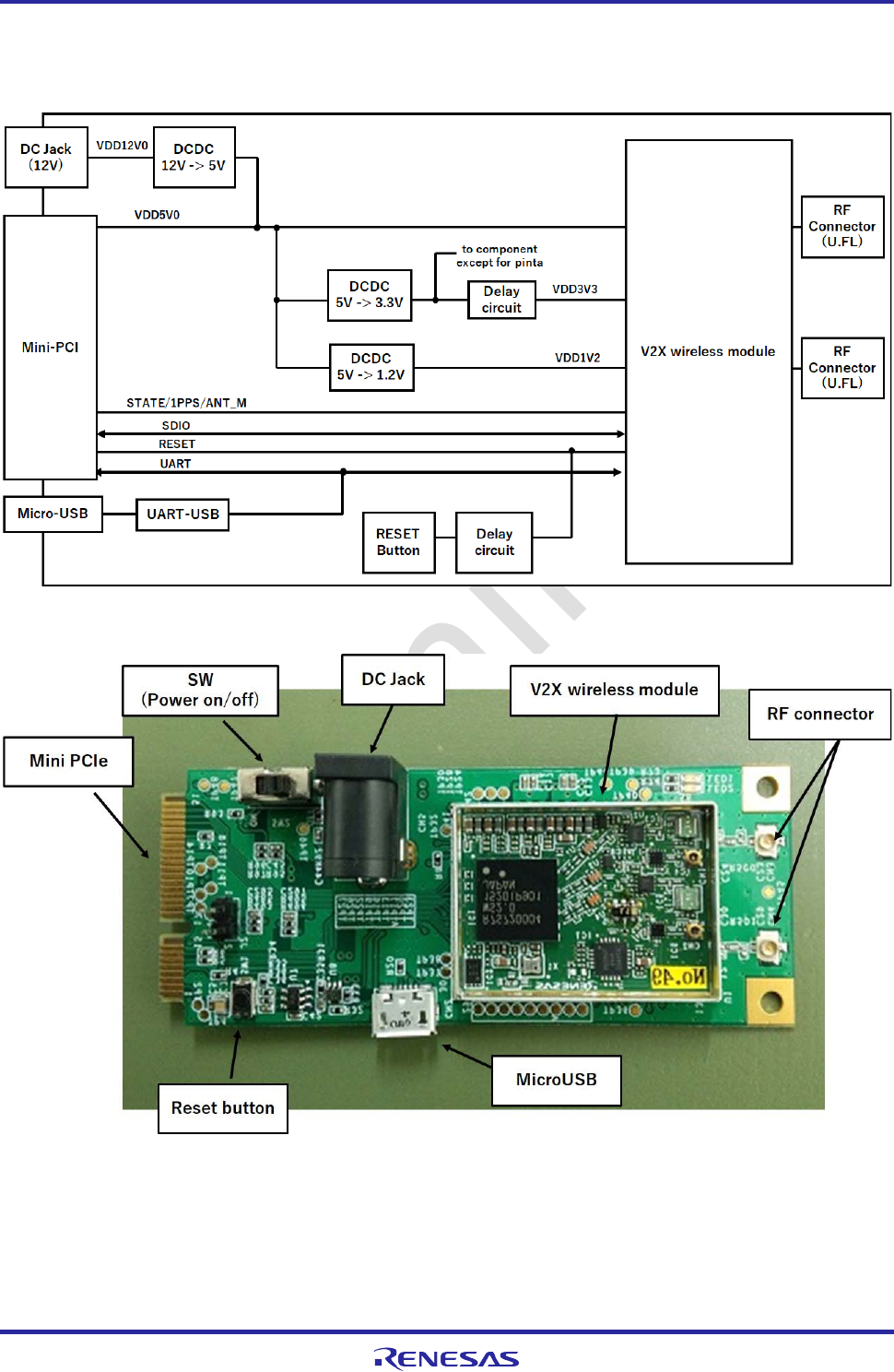
Renesas Electronics confidential
GAC-B-17-0004 Page 6 of 25
17th Jan. 2017
2. Board description
2.1 BLOCK Diagram

Renesas Electronics confidential
GAC-B-17-0004 Page 7 of 25
17th Jan. 2017
2.2 Mini PCIE pin information
Pin Pin Name I/O Functional Description
1
RESERVE
I/O
-
No connection(only connected to test pin)
2 RESERVE I/O - No connection
3 RESERVE I/O - No connection(only connected to test pin)
4 GND - GND GND
5 5.0V - Voltage Supply 5V voltage supply
6 5.0V - Voltage Supply 5V voltage supply
7 RESET I CMOS Schmitt Trigger Input
(with Pull-Up) System reset input (Low Active)
8
1PPS
I
CMOS Schmitt Trigger I
(with Pull-Down)
If you don’t use, select open.
9 GND - GND GND
10 RESERVE I/O - No connection(only connected to test pin)
11
UART0_TXD
O
CMOS Output
UART0 Tx signal [TXD]
12
ANT_M
I
CMOS Schmitt Trigger I
(with Pull-Up)
RX Diversity Enable selects.
- High : Diversity
- Low : Single_ANT B
If you don’t use, select open.
13
UART0_RXD
I
CMOS Schmitt Trigger Input
UART0 Rx signal [RXD]
14 RESERVE I/O - No connection(only connected to test pin)
15 GND - GND GND
16
STATE
O
CMOS Output
Status indication signal
17 RESERVE I/O - No connection(only connected to test pin)
18 GND - GND GND
19 RESERVE I/O - No connection(only connected to test pin)
20 RESERVE I/O - No connection(only connected to test pin)
21 GND - GND GND
22 RESERVE I/O - No connection(only connected to test pin)
23 RESERVE I/O - No connection(only connected to test pin)
24 5.0V - Voltage Supply 5V voltage supply
25 RESERVE I/O - No connection(only connected to test pin)
26 GND - GND GND
27 GND - GND GND
28 5.0V - Voltage Supply 5V voltage supply
29 GND - GND GND
30 RESERVE I/O - No connection(only connected to test pin)
31 RESERVE I/O - No connection(only connected to test pin)
32 RESERVE I/O - No connection(only connected to test pin)
33 RESERVE I/O - No connection(only connected to test pin)
34 GND - GND GND
35 GND - GND GND
36 RESERVE I/O - No connection(only connected to test pin)
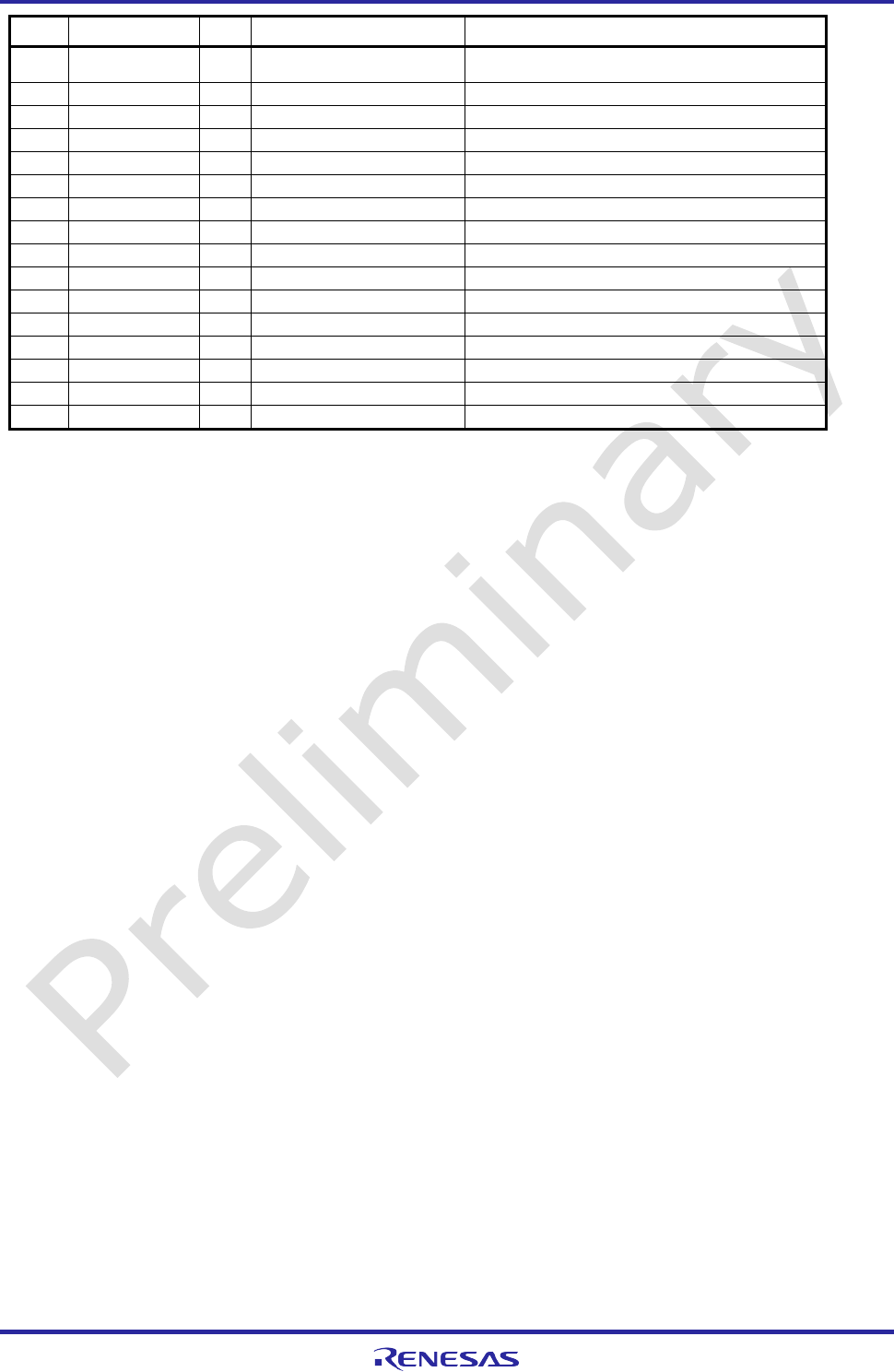
Renesas Electronics confidential
GAC-B-17-0004 Page 8 of 25
17th Jan. 2017
Pin Pin Name I/O Functional Description
37
SDIO_CLK
I
CMOS Schmitt Trigger Input
(with Pull-Up)
SDIO clock [CLK]
38 RESERVE I/O - No connection(only connected to test pin)
39 RESERVE I/O - No connection(only connected to test pin)
40 GND - GND GND
41 GND - GND GND(Pull Down
42 RESERVE I/O - No connection(only connected to test pin)
43
SDIO_DAT3
I/O
CMOS I/O with Pull-Up
SDIO data [DAT3]
44 RESERVE I/O - No connection(only connected to test pin)
45
SDIO_DAT2
I/O
CMOS I/O with Pull-Up
SDIO data [DAT2]
46 RESERVE I/O - No connection(only connected to test pin)
47
SDIO_DAT1
I/O
CMOS I/O with Pull-Up
SDIO data [DAT1]
48
5.0V
-
Voltage Supply
5V voltage supply
49
SDIO_DAT0
I/O
CMOS I/O with Pull-Up
SDIO data [DAT0]
50 GND - GND GND
51
SDIO_CMD
I/O
CMOS I/O with Pull-Up
SDIO command [CMD]
52 RESERVE I/O - No connection
2.3 Power Supply
Tortuga are powered from the HOST board if used in conjunction with the HOST board.
For standalone operation Tortuga are powered from the AC adapter(12V/2A).
2.4 Usage for standalone operation
Please refer to the “UW2b Tortuga test TP quick manual“ for usage of standalone operation.
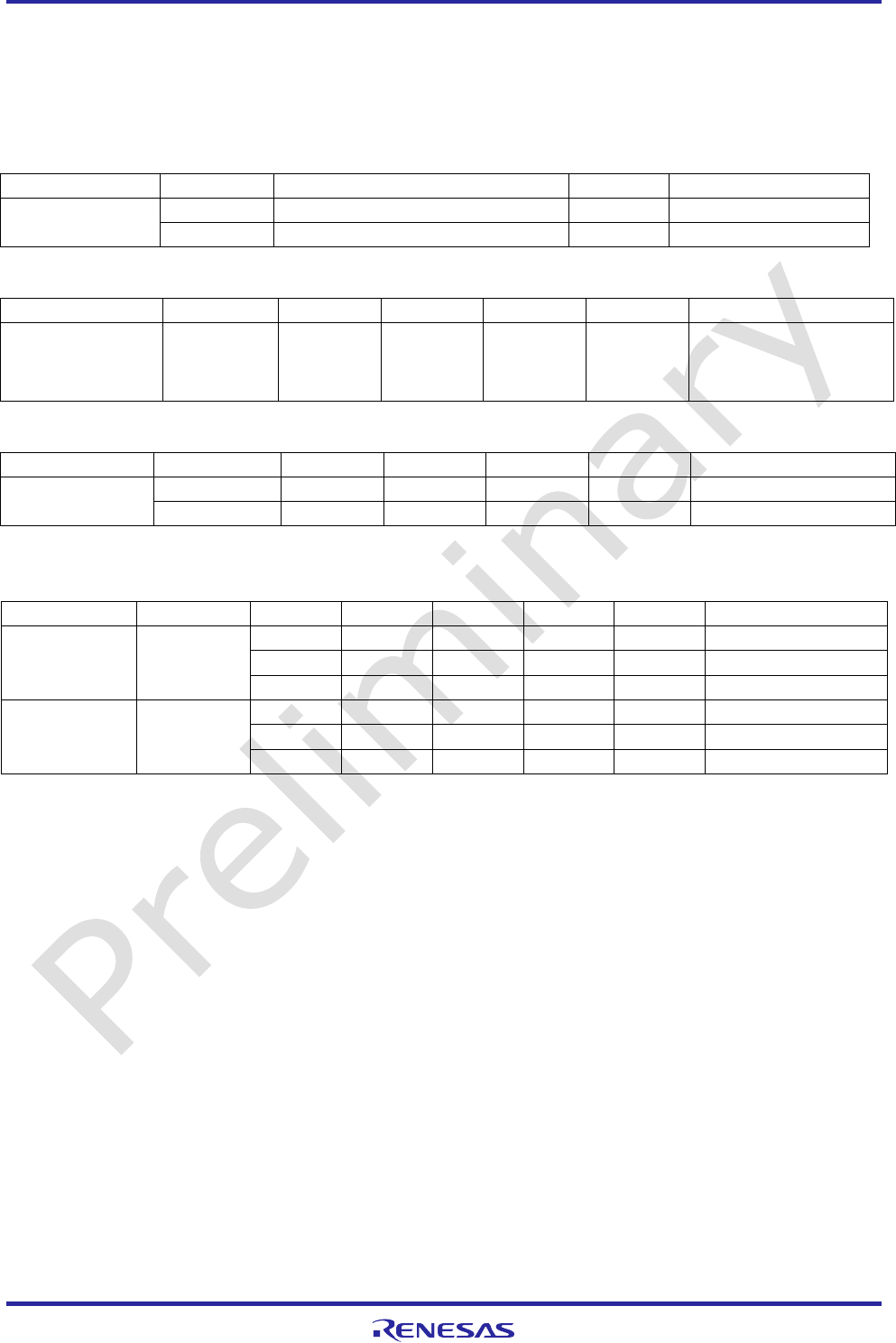
Renesas Electronics confidential
GAC-B-17-0004 Page 9 of 25
17th Jan. 2017
3. Function details
*VDD1V2 / VDD3V0 / VDD5V0 / VDD12V0 described in this chapter are correspond to symbol described in “2.1
Block diagram”. 3.1 Absolute Maximum Rating
Item
Symbol
Maximum Rate
Unit
Condition
Supply Voltage VDD12V0 -0.3 ~ +43.5 [V] From DC jack
VDD5V0
-0.3 ~ +6.0
[V]
From Mini PCIE
3.2 Electrical Characteristics
Operation Temperature
Item
Symbol
Min
Typ
Max
Unit
Condition
Operation
temperature Ta +25 [°C]
Operation Voltage
Item Symbol Min Typ Max Unit Condition
Supply Voltage
VDD12V0
12
[V]
From DC jack
VDD5V0 4.75 5 5.25 [V] From mini PCIE
DC characteristic
Ta = 25°C, standalone operation, VDD12V0=12V(AC adapter)
Item Symbol Min Typ Max Unit Condition
Current
consumption
(diversity off)
VDD12V0
TBD
[mA]
Listen mode
TBD [mA] Rx mode
TBD
[mA] Tx mode (@24dBm)
Current
consumption
(diversity on)
VDD12V0
TBD
[mA]
Listen mode
TBD [mA] Rx mode
TBD
[mA] Tx mode (@24dBm)

Renesas Electronics confidential
GAC-B-17-0004 Page 10 of 25
17th Jan. 2017
3.3 RF characteristic
*1 typical operating condition (Just informative, not guaranteed.):
*1 HW = Tortuga7, Ta = 25°C, standalone operation, VDD12V0=12V(AC adapter)
*1 Measurement point is circled in red in the figure below
3.3.1 Receive characteristic
Min
Typ
Max
Unit
Condition
Frequency range 5850 5925 [MHz]
Input VSWR
2.0
-
5890MHz
Minimum Sensitivity
(Diversity off)
-94 [dBm] Data rate = 3Mbps
-93
[dBm]
Data rate = 6Mbps
-87
[dBm]
Data rate = 12Mbps
-77
[dBm]
Data rate = 27Mbps
Minimum Sensitivity
(Diversity on)
-94 [dBm] Data rate = 3Mbps
-94
[dBm]
Data rate = 6Mbps
-87
[dBm]
Data rate = 12Mbps
-80
[dBm]
Data rate = 27Mbps
Maximum
Input Level
(Diversity off)
-20
[dBm]
Data rate = 27Mbps
Maximum
Input Level
(Diversity on)
-20
[dBm]
Data rate = 27Mbps
Adjacent channel rejection
(Diversity off)
30
[dB]
Data rate = 3Mbps
29
[dB]
Data rate = 6Mbps
28
[dB]
Data rate = 12Mbps
18
[dB]
Data rate = 27Mbps
Nonadjacent Adjacent channel
rejection
(Diversity off)
44
[dB]
Data rate = 3Mbps
41
[dB]
Data rate = 6Mbps
36
[dB]
Data rate = 12Mbps
27
[dB]
Data rate = 27Mbps
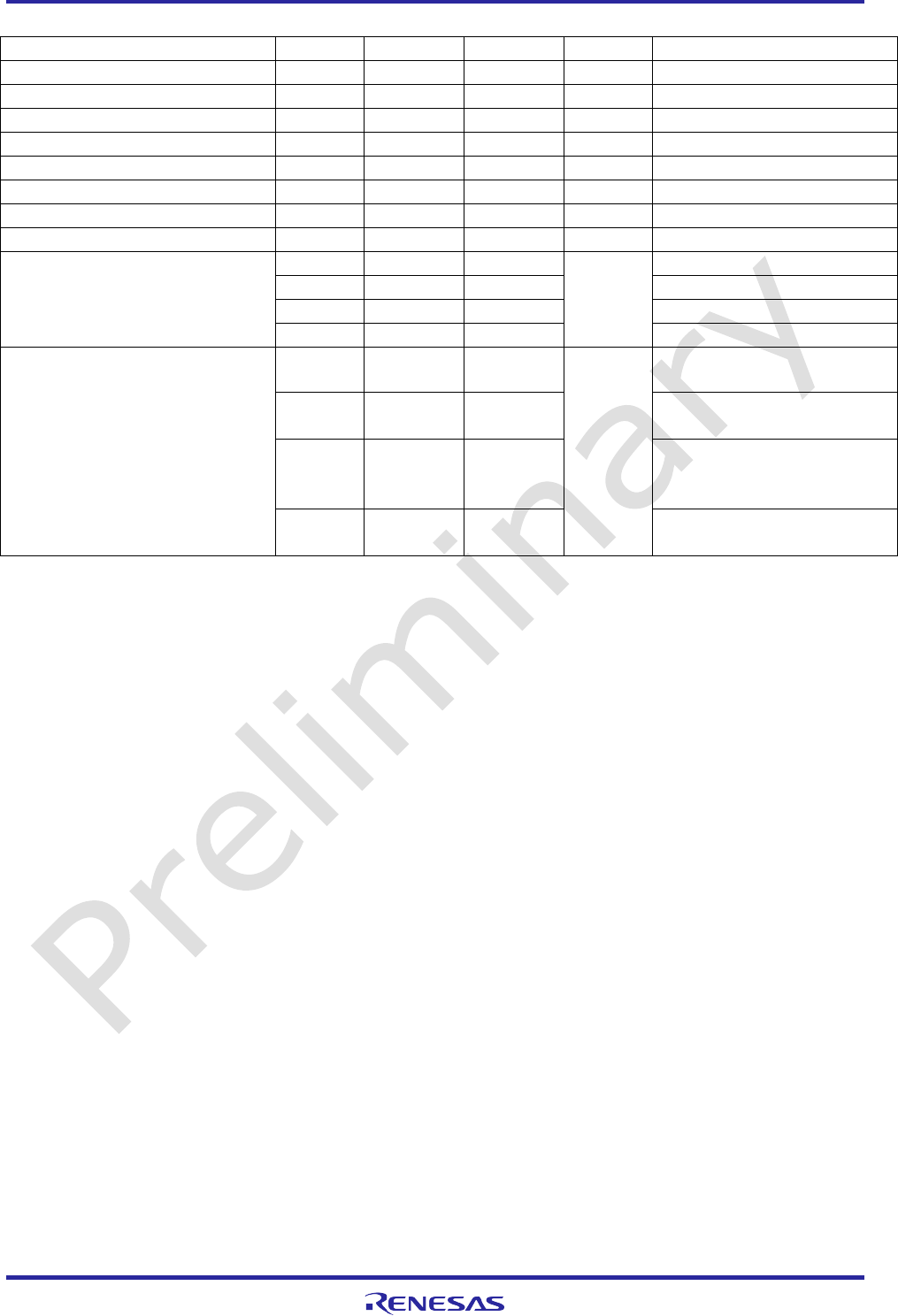
Renesas Electronics confidential
GAC-B-17-0004 Page 11 of 25
17th Jan. 2017
3.3.2 Transmit characteristic
Min
Typ
Max
Unit
Condition
Frequency range
5850
5925
[MHz]
Output VSWR
2.0
5890MHz
Maximum out put Power(ANT_B)
24
[dBm]
5890MHz
Maximum out put Power(ANT_A)
-8
[dBm]
5890MHz
Minimum out put Power(ANT_B)
-7
[dBm]
5890MHz
Minimum out put Power(ANT_A)
-35
[dBm]
5890MHz
Output Power control range
30
[dB]
5890MHz
Power control step
0.5
[dB]
Relative constellation error
-28
[dB]
Data rate = 3Mbps
-28
Data rate = 6Mbps
-28
Data rate = 12Mbps
-28
Data rate = 27Mbps
Spectrum Mask
(in band)
-31
[dBr/100
KHz]
@5890M
Hz
4.5MHz<f<5.0MHz offset Pout
= 24dBm
-33
5.0MHz<f<5.5MHz offset
Pout =24dBm
-36
5.5MHz<f<10.0MHz offset
±5.5MHz Pout=
24dBm
-54
10.0MHz<f<15.0MHz offset
Pout=24dBm
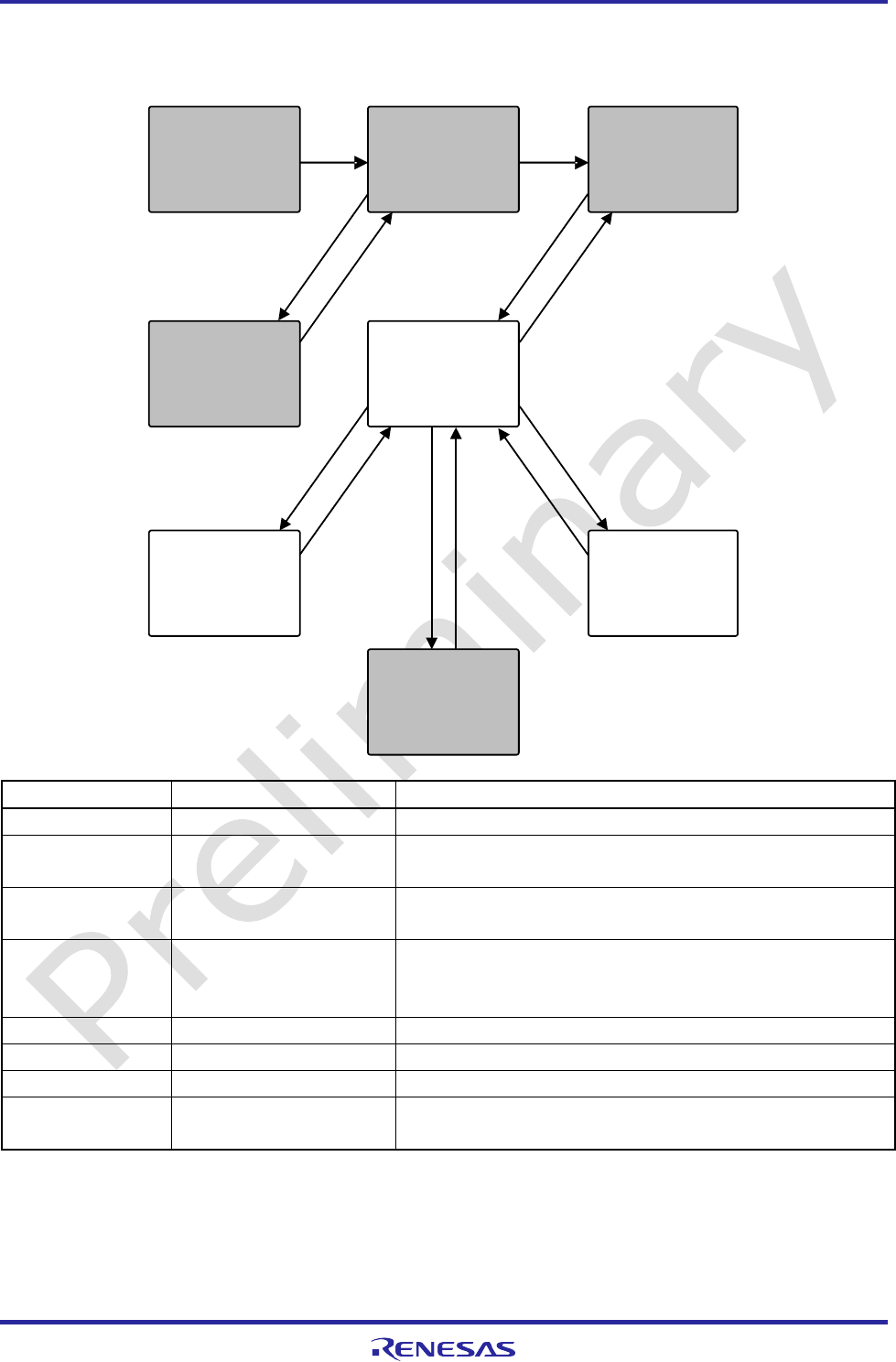
Renesas Electronics confidential
GAC-B-17-0004 Page 12 of 25
17th Jan. 2017
3.4 Mode Transfer Definition and sub board control
Mode State Note
Reset Reset assert. Transfer from the mode to the Reset mode by reset signal
INIT Initialize RF block, internal
register and other function.
Initialized LSI function after booting firmware
IDLE Waiting start request from Host
CPU
Listen Waiting the packet indication. Transfer the Receive mode by detecting the receive signal power, or
transfer the Transmit mode by internal transmit request, or transfer the
IDLE mode by stop request from Host CPU
Receive Receive signal processing.
Transmit Transmit signal processing.
Frequency Change Changing Tx/Rx frequency.
TEST Test mode. Operate loop back calibration and other test for performance
optimization
The MAC firmware and BBWLAN control the external RF circuits via the control pins ANT_SW_P, ANT_SW_N,
Reset INIT
Receive
IDLE
Transmit
Listen
Initialization
Complete
Reset
De- assertion
TEST
Frequency
Change Request
Frequency
Change
Start TEST
Finish TEST
Frequency
Change Complete
Start Request
(from Host CPU)
Stop Request
(from Host CPU)
Packet (Energy)
Detection
Receive
Complete
Transmission
Request
Transmission
Complete
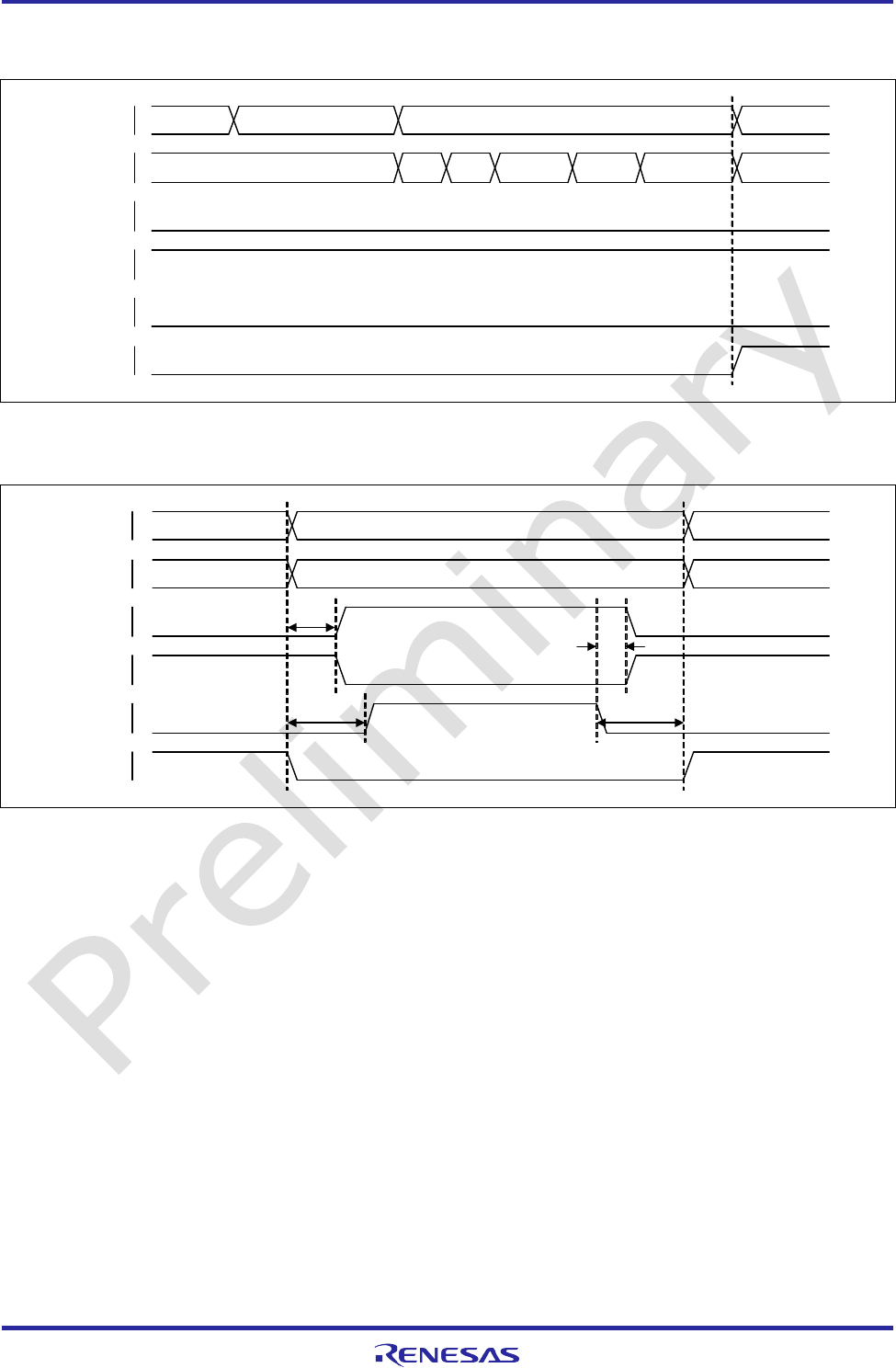
Renesas Electronics confidential
GAC-B-17-0004 Page 13 of 25
17th Jan. 2017
PAEN(Pin name = PAPE) and RFCNTL. The operation of these external RF circuit control pins according to the internal
transceiver state and/or operation inside RF block are summarized in Fig. 3 and Fig. 4.
Figure 3 Operation of the External RF Circuit Control Pins (Reset and Initialization)
Figure 4 Operation of the External RF Circuit Control Pins (Transmission and Listening)
Remarks)
*1) The assertion timings of ANT_SW_P/N and PAEN1 can be tuned from 0 to 12.7us independently.
*2) RFCNTL2, PAEN2, ANT_M pins are reserved for the future as an optional function which might be realized by the
MAC firmware. The detail operations are not defined in this hardware document.
RX
Listen
Reset
Idle Idle Calibration Warm-up
ANT_SW_P
ANT_SW_N
PAEN1
RFCNTL1
‘Low’
‘High’
‘Low’
‘Low’
Operation
Inside RF
Transceiver
state INIT
(CPU Initialization) INIT
(RF/PHY Initialization)
RF
Reset Register
Program
RX
ListenTransmit
RX TX
ANT_SW_P
ANT_SW_N
PAEN1
RFCNTL1
‘Low’
‘High’
Listen
‘High’
‘Low’
0 to 12.7 us
0 to 12.7 us 0 to 12.7 us
0 or 1 or 2 us
Transceiver
state
Operation
Inside RF
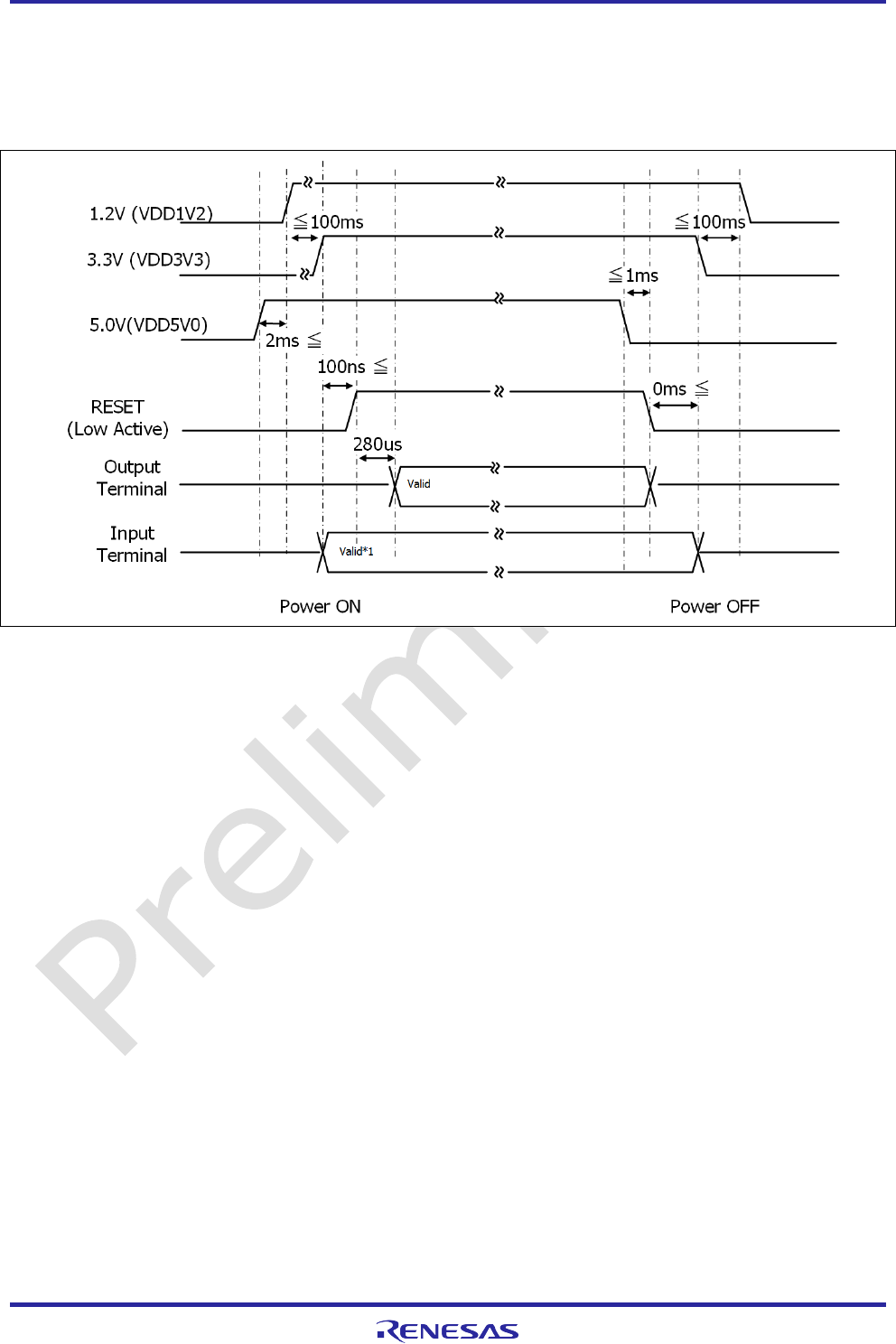
Renesas Electronics confidential
GAC-B-17-0004 Page 14 of 25
17th Jan. 2017
3.5 Power up/down, Reset, WDT sequence
3.5.1 Power On / Off Sequence
Figure 5 Operation of the External RF Circuit Control Pins (Transmission and Listening)
*1 “Valid” to module input pin in the figure means drive valid data (or pull-up/down) from external.
*2 each input signal level to Input from external shall not exceed VDD+0.3V (VDD3V3, VDD1V2,VDD5V0)
correspondingly. .
*3 until 280us after reset release, output pin is not defined. After that, it drives initial value for each pin.
For power supply on, apply power in the order, 5.0V , 1.2V , 3.3V, and after passed more than 100ns of Low level,
RESET is released. In order to PLL reset and to stabilize PLL oscillation, after about 280us, clock is supplied to LSI.
For power off, the reverse order shall be done, i.e. RESET is “Active”, and switch off 5.0V , 3.3 V and 1.2 V.
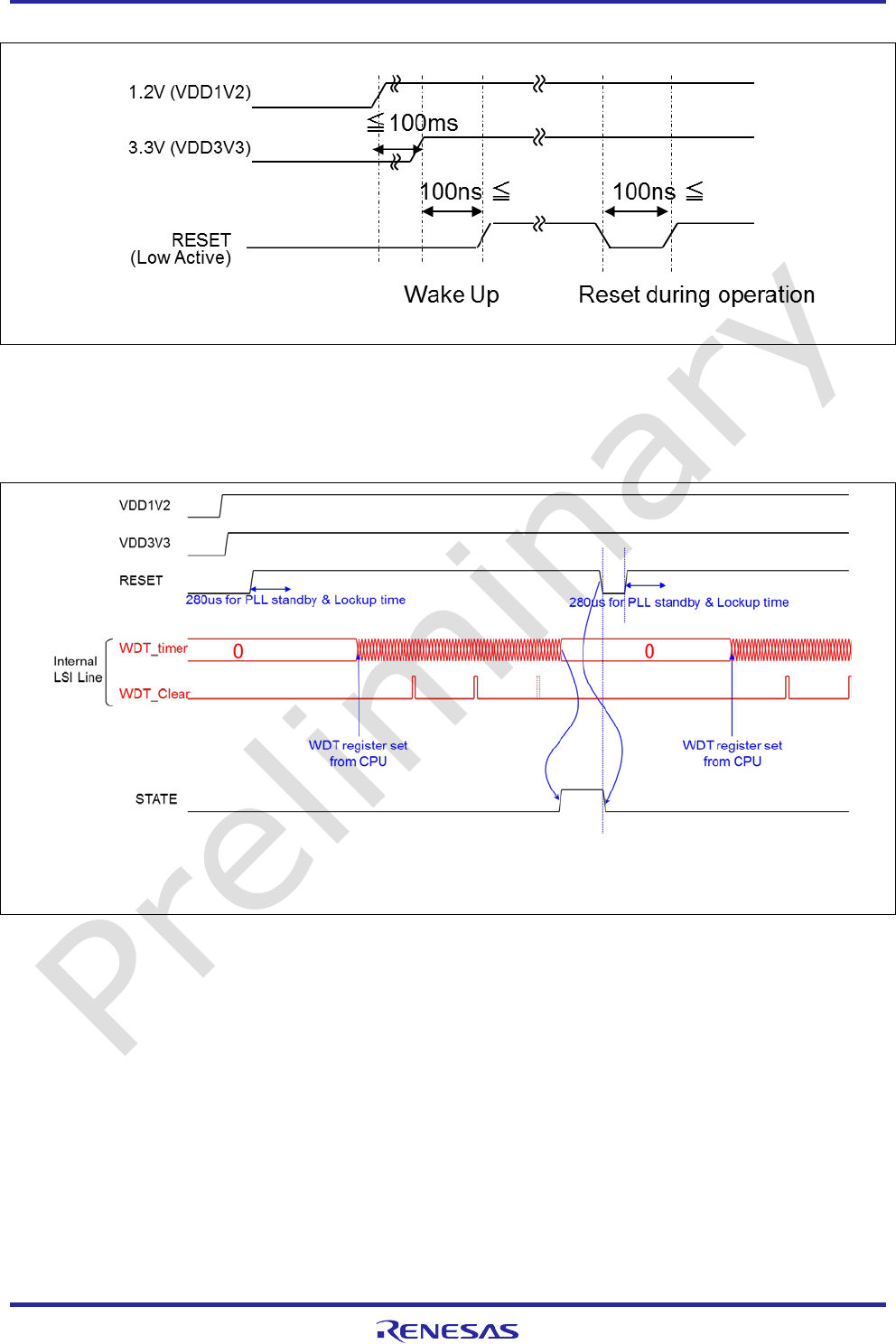
Renesas Electronics confidential
GAC-B-17-0004 Page 15 of 25
17th Jan. 2017
3.5.2 Reset sequence
With making RESET pin ”Low”, LSI reset is executed. To be surely reset, hold RESETB level ”Low” for minimum
100ns. Also for reset under operation, control RESET level ”Low” for minimum 100ns.
3.5.3 WDT Reset timing
When Watch-dog time (WDT) counter becomes overflow, STATE signal output “High”, and informs WDT flow over to
host CPU software. Then LSI stops as reset status. Host CPU software is able to re-start LSI with external RESET
signal.
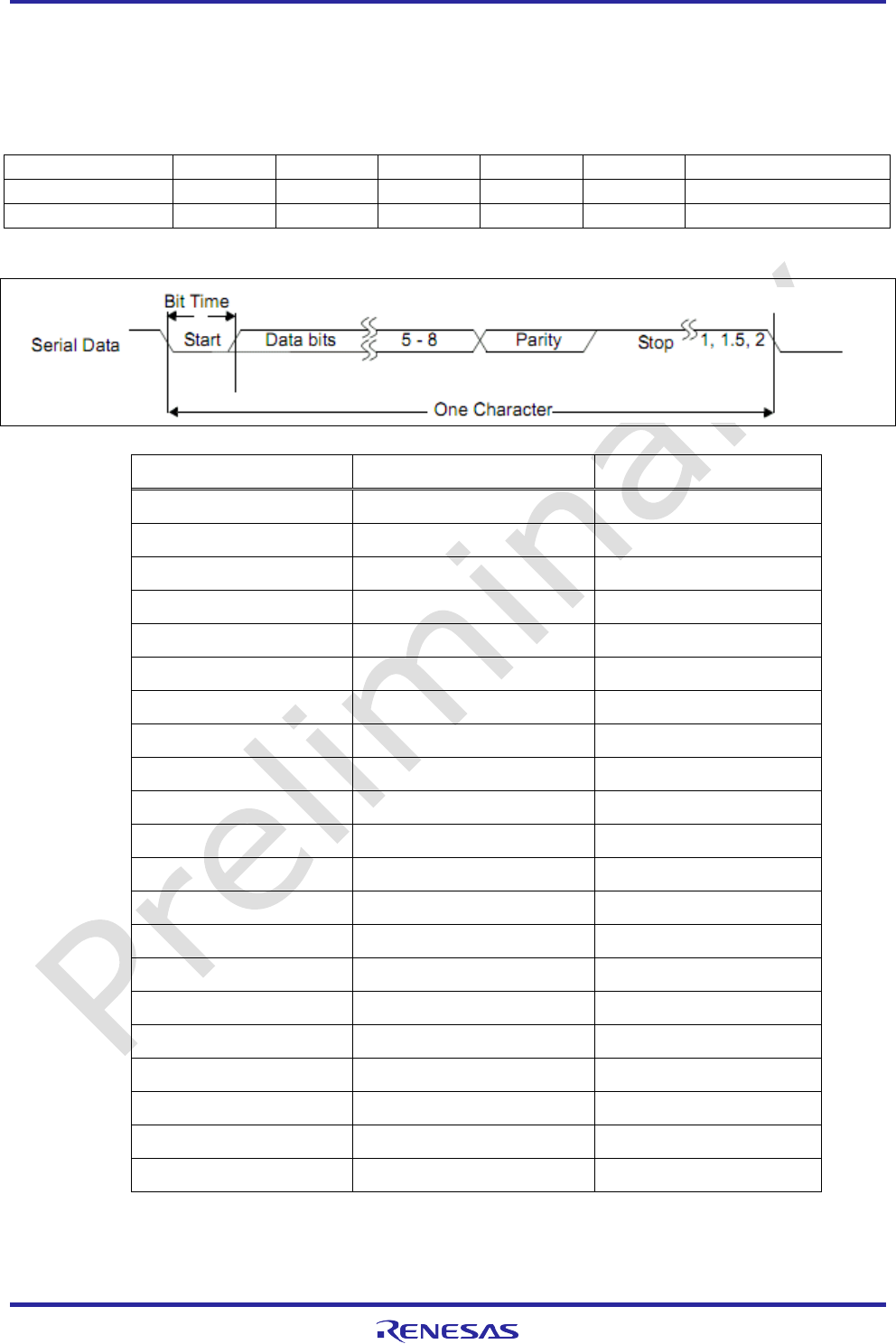
Renesas Electronics confidential
GAC-B-17-0004 Page 16 of 25
17th Jan. 2017
3.6 Logic interface AC Characteristics
3.6.1 UART sequence
UART Interface characteristic
Ta = 25°C, VDD12V0
Item Symbol Min Typ Max Unit Condition
Baud rate
fUTRXD
50
128000
bps
Bit Time tUTRXD 7.81 20000 us tUTRXD=1/fUTRXD
UART Serial Data Format
Baud Rate (bps) Hex Divisor Setting Bit Time (us)
50
0x61A8
20000.00
75 0x411B 13333.33
110
0x2C64
9090.91
134.5 0x244E 7434.94
150
0x208D
6666.67
300 0x1047 3333.33
600
0x0823
1666.67
1200 0x0412 833.33
1800
0x02B6
555.56
2000 0x0271 500.00
2400
0x0209
416.67
3600 0x015B 277.78
4800
0x0104
208.33
7200 0x00AE 138.89
9600
0x0082
104.17
19200 0x0041 52.08
38400
0x0021
26.04
56000 0x0016 17.86
57600
0x0016
17.36
115200 0x000B 8.68
128000
0x000A
7.81
3.6.2 SDIO sequence
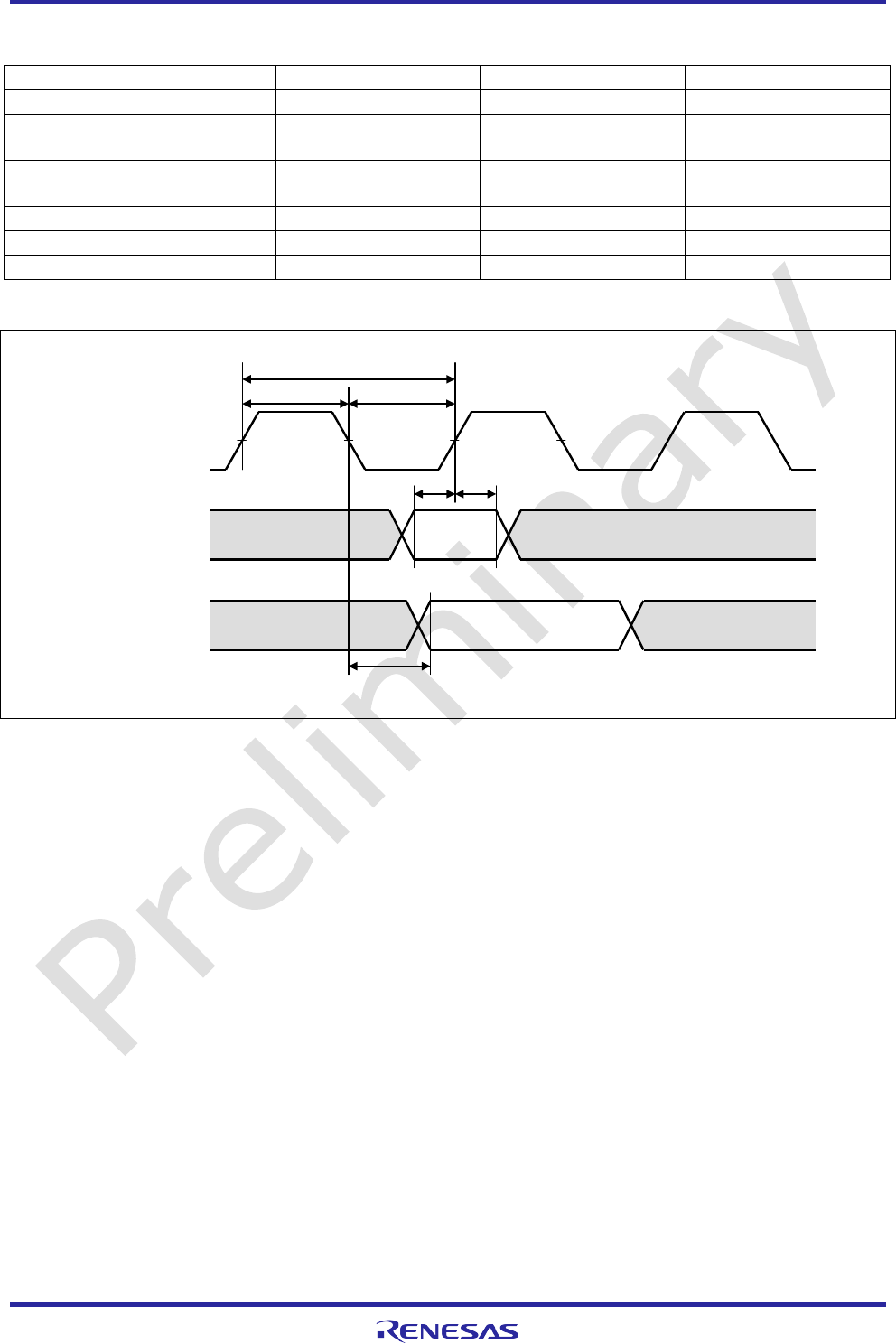
Renesas Electronics confidential
GAC-B-17-0004 Page 17 of 25
17th Jan. 2017
SDIO Interface characteristic
Ta = 25°C, VDD12V0
Item
Symbol
Min
Typ
Max
Unit
Condition
Clock frequency Tckf 25 MHz
Clock low position
holding time
Tckwl
10
ns
Clock high position
holding time
Tckwh
10
ns
Input set-up time
Tisu
5
ns
Input holding time
Tih
5
ns
Output delay time
Todly
0
14
ns
CL=25pF
SDIO Timing Format
Tckf
Tckwl Tckwh
Tisu
Todly
SDIO_CLK
SDIO_CMD
SDIO_DAT*
(Input)
(Input)
SDIO_CMD
SDIO_DAT*
(Output)
Tih

Renesas Electronics confidential
GAC-B-17-0004 Page 18 of 25
17th Jan. 2017
3.6.3 1PPS sequence
1PPS Interface characteristic
Ta = 25°C, VDD12V0
Item Symbol Min Typ Max Unit Condition
PPS period Tppsp 1.0 sec
PPS low position
holding time
Tppsl 1.0 us
PPS high position
holding time
Tppsh 1.0 us
Figure 6 1PPS Interface Timing Format
Remark)
This interface is valid for the United States area. For the Europe area, this information can be ignored.
4. Appendix – Validation configuration information
Equipment information
No
Name
Information
1
VSA
FSQ-26(R&S)
2
VSG
E4438C(Agilent)
3
PC
Versa Pro VB-D(NEC)
5. Regulatory Warning Statements
Federal Communication Commission Interference Statement:
This device complies with Part 15 of the FCC Rules. Operation is subject to the following two conditions:
(1)This device may not cause harmful interference, and (2) this device must accept any interference received, including
interference that may cause undesired operation.
This equipment has been tested and found to comply with the limits for a Class B digital device, pursuant to Part 15 of
the FCC Rules. These limits are designed to provide reasonable protection against harmful interference in a residential
installation. This equipment generates, uses and can radiate radio frequency energy and, if not installed and used in
accordance with the instructions, may cause harmful interference to radio communications.
However, there is no guarantee that interference will not occur in a particular installation. If this equipment does cause
harmful interference to radio or television reception, which can be determined by turning the equipment off and on, the
user is encouraged to try to correct the interference by one of the following measures:
- Reorient or relocate the receiving antenna.
- Increase the separation between the equipment and receiver.
- Connect the equipment into an outlet on a circuit different from that to which the receiver is connected.
- Consult the dealer or an experienced radio/TV technician for help.
FCC Caution: Any changes or modifications not expressly approved by the party responsible for compliance could void
Tppsp
Tppsh
Tppsl
1PPS
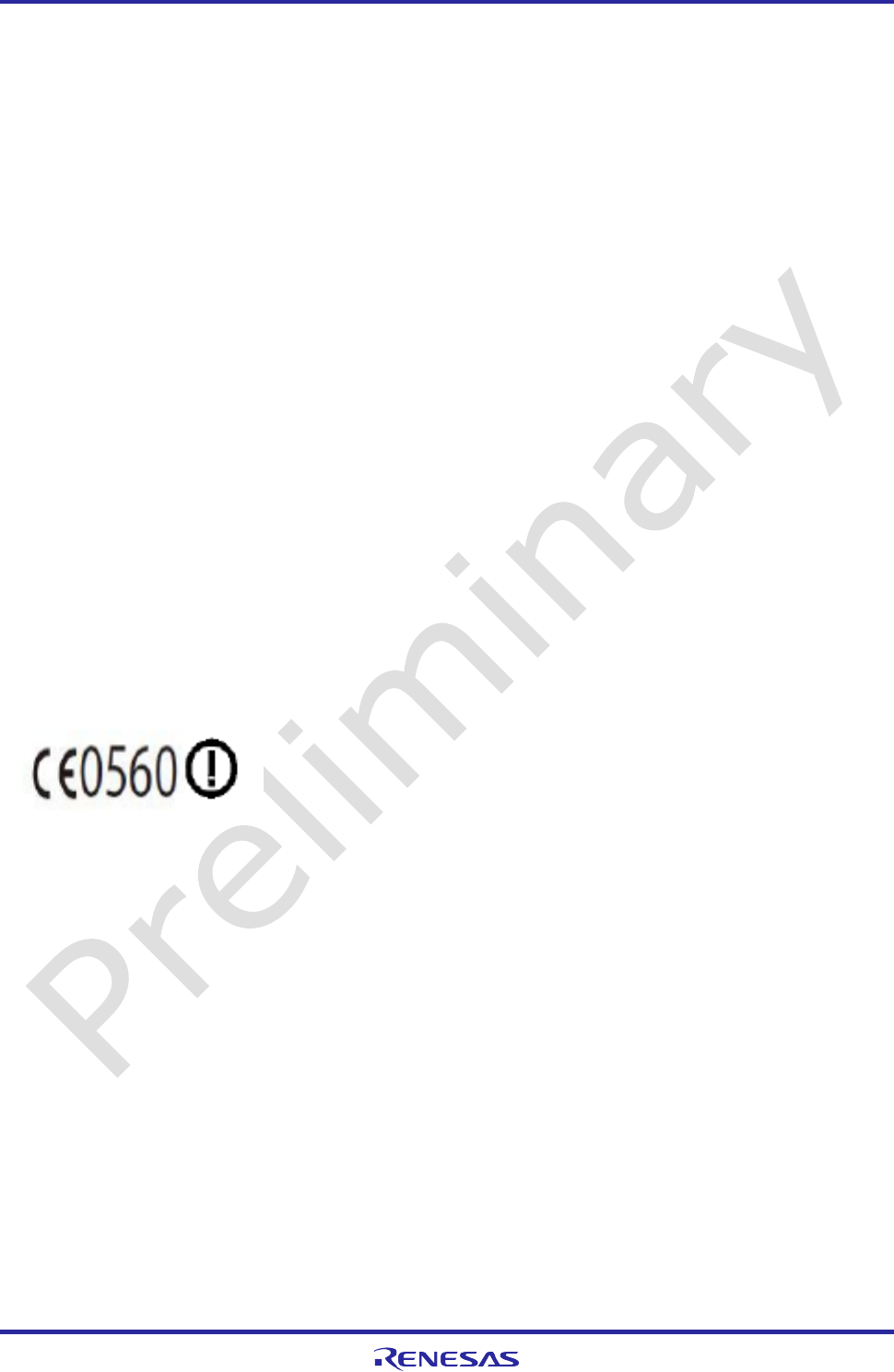
of 20 cm between the radiator and your body.
This equipment should be installed and operated with minimum distance
intended operation as described in this manual.
all the other requirements specified in Part 90 of the FCC
Renesas Electronics confidential
GAC-B-17-0004 Page 19 of 25
17th Jan. 2017
the user’s authority to operate this equipment.
This transmitter must not be co-located or operating in conjunction with any other antenna or transmitter.
For operation within the 5860MHz~5920Mhz frequency range, it is restricted to indoor environment. This device meets
Rules
Caution: Risk of electric Shock, dry location use only
Radiation Exposure Statement:
The product comply with the FCC portable RF exposure limit set forth for an uncontrolled environment and are safe for
RF exposure reduction can be achieved if the product can be
kept as far as possible from the user body or set the device to lower
output power if such function is available.
Integrator Instructions
EUT Name: Tortuga
FCC ID: 2AHMN-W2R
Model Name:
RTK00V2X720MTORS7J
Additional Regulatory Conformance Testing and/or Submissions
Required by the Integrator:
The OEM integrator is responsible for additional system-level EMI/EMC and Product
Safety testing and certification
that applies in the U.S. and other countries to the host
system containing the Module. This includes, but is not limited to,
Federal
Communications Commission (“FCC”) Part 15 Class B Digital Emissions, and ETSI EN
301 489-17.
These system-level EMC tests are to be done with the Module installed and included in the scope of the submission.
European Community R&TTE
Notice: Observe the national local regulations in the location where the device is to beused. This device may
be restricted for use in some or all member states of the European Union (EU).
The device complies with RF specifications when the device used at least 20cm from human body.
The users has to turn off the 5.9GHz WiFi in outdoor environment.
The further
W2R.2AHMN
ORIGINALEQUIPMENTMANUFACTURER(OEM)NOTES
TheOEMmustcertifythefinalendproducttocomplywithunintentionalradiators(FCCSections15.107and
15.109)beforedeclaringcomplianceofthefinalproducttoPart15oftheFCCrulesandregulations.Integration
intodevicesthataredirectlyorindirectlyconnectedtoAClinesmustaddwithClassIIPermissiveChange.
TheOEMmustcomplywiththeFCClabelingrequirements.Ifthemodule’slabelisnotvisiblewheninstalled,
thenanadditionalpermanentlabelmustbeappliedontheoutsideofthefinishedproductwhichstates:
“ContainstransmittermoduleFCCID: ‐ Additionally,thefollowingstatementshouldbeincluded
onthelabelandinthefinalproduct’susermanual:“ThisdevicecomplieswithPart15oftheFCCRules.
Operationissubjecttothefollowingtwoconditions:(1)Thisdevicemaynotcauseharmfulinterferences,and
(2)thisdevicemustacceptanyinterferencereceived,includinginterferencethatmaycauseundesired
operation.”
Themoduleislimitedtoinstallationinmobileorfixedapplications.Separateapprovalisrequiredforallother
operatingconfigurations,includingportableconfigurationwithrespecttoPart2.1093anddifferentantenna
configurations.
Amoduleormodulescanonlybeusedwithoutadditionalauthorizationsiftheyhavebeentestedandgranted
underthesameintendedend‐useoperationalconditions,includingsimultaneoustransmissionoperations.
Whentheyhavenotbeentestedandgrantedinthismanner,additionaltestingand/orFCCapplicationfiling
mayberequired.Themoststraightforwardapproachtoaddressadditionaltestingconditionsistohavethe
granteeresponsibleforthecertificationofatleastoneofthemodulessubmitapermissivechangeapplication.
Whenhavingamodulegranteefileapermissivechangeisnotpracticalorfeasible,thefollowingguidance
providessomeadditionaloptionsforhostmanufacturers.Integrationsusingmoduleswhereadditionaltesting
and/orFCCapplicationfiling(s)mayberequiredare:(A)amoduleusedindevicesrequiringadditionalRF
exposurecomplianceinformation(e.g.,MPEevaluationorSARtesting);(B)limitedand/orsplitmodulesnot
meetingallofthemodulerequirements;and(C)simultaneoustransmissionsforindependentcollocated
transmittersnotpreviouslygrantedtogether.
This Module is full modular approval, it is limited to OEM installation ONLY.
Integration into devices that are directly or indirectly connected to AC lines must add with Class II Permissive Change.
(OEM) Integrator has to assure compliance of the entire end product incluld the integrated Module.
Additional measurements (15B) and/or equipment authorizations (e.g Verification) may need to be addressed
depending on co-location or simultaneous transmission issues if applicable.
(OEM) Integrator is reminded to assure that these installation instructions will not be made available to the end user
of the final host device.
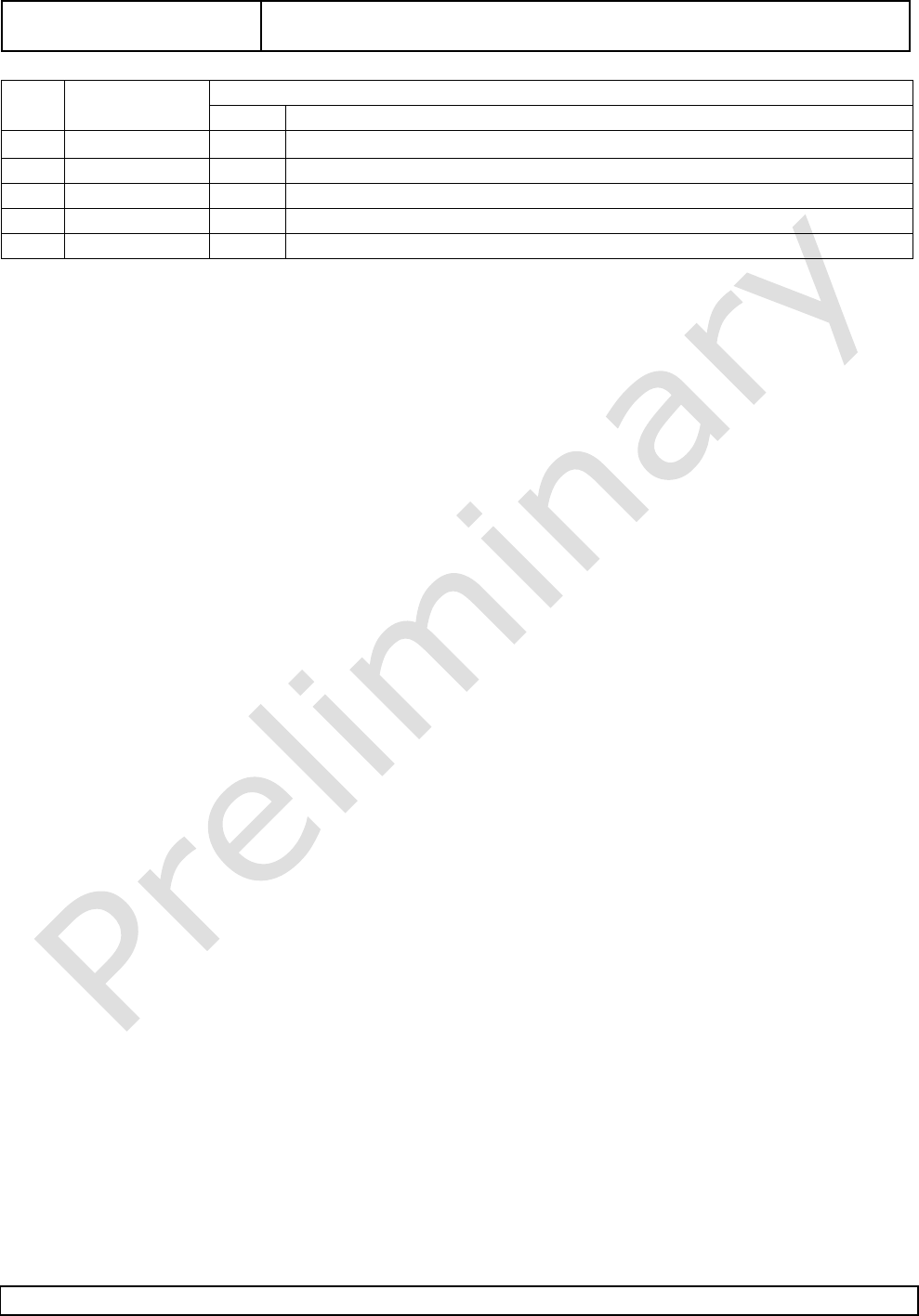
All trademarks and registered trademarks are the property of their respective owners.
C - 1
Revision Record RTK00V2X720MTORS7J User’s Manual : Hardware
Rev. date
Change summary
Page
Details
1.0 17.Jan.2017 1
st
Documents (Hisataka TAKAGI)

General Precautions in the Handling of MPU/MCU Products
The following usage notes are applicable to all MPU/MCU products from Renesas. For detailed usage notes on the
products covered by this document, refer to the relevant sections of the document as well as any technical updates that
have been issued for the products.
1. Handling of Unused Pins
Handle unused pins in accordance with the directions given under Handling of Unused Pins in the manual.
The input pins of CMOS products are generally in the high-impedance state. In operation with an unused pin
in the open-circuit state, extra electromagnetic noise is induced in the vicinity of LSI, an associated
shoot-through current flows internally, and malfunctions occur due to the false recognition of the pin state as
an input signal become possible. Unused pins should be handled as described under Handling of Unused
Pins in the manual.
2. Processing at Power-on
The state of the product is undefined at the moment when power is supplied.
The states of internal circuits in the LSI are indeterminate and the states of register settings and pins are
undefined at the moment when power is supplied.
In a finished product where the reset signal is applied to the external reset pin, the states of pins are not
guaranteed from the moment when power is supplied until the reset process is completed.
In a similar way, the states of pins in a product that is reset by an on-chip power-on reset function are not
guaranteed from the moment when power is supplied until the power reaches the level at which resetting has
been specified.
3. Prohibition of Access to Reserved Addresses
Access to reserved addresses is prohibited.
The reserved addresses are provided for the possible future expansion of functions. Do not access these
addresses; the correct operation of LSI is not guaranteed if they are accessed.
4. Clock Signals
After applying a reset, only release the reset line after the operating clock signal has become stable. When
switching the clock signal during program execution, wait until the target clock signal has stabilized.
When the clock signal is generated with an external resonator (or from an external oscillator) during a reset,
ensure that the reset line is only released after full stabilization of the clock signal. Moreover, when
switching to a clock signal produced with an external resonator (or by an external oscillator) while program
execution is in progress, wait until the target clock signal is stable.
5. Differences between Products
Before changing from one product to another, i.e. to a product with a different part number, confirm that the
change will not lead to problems.
The characteristics of an MPU or MCU in the same group but having a different part number may differ in
terms of the internal memory capacity, layout pattern, and other factors, which can affect the ranges of
electrical characteristics, such as characteristic values, operating margins, immunity to noise, and amount of
radiated noise. When changing to a product with a different part number, implement a system-evaluation test
for the given product.
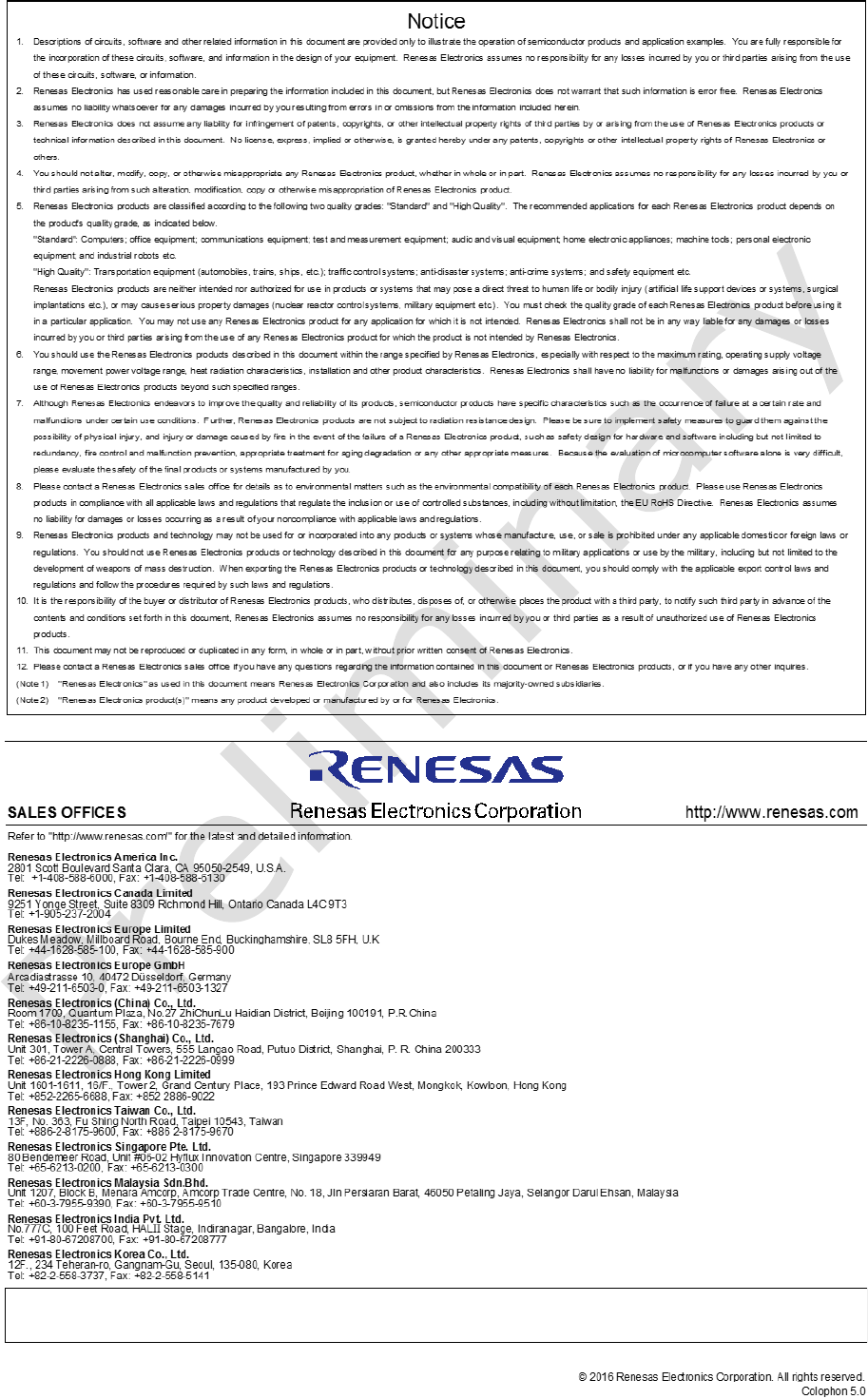

RTK00V2X720MTORS7J
User’s Manual: Hardware
Publication Date: Rev. 1.0 Jan. 17, 2017
Published by: Renesas Electronics Corporation

RTK00V2X720MTORS7J